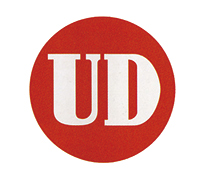Upon entering the 1950s, Japan had emerged from a period of recovery and in preparation for new economic growth was busy constructing infrastructure that included power sources, roads, railways, ports and large-scale plants.
A deficiency in transportation capacity came under close scrutiny, however, due to its importance in driving infrastructure development. As a result, demand for large, high-horsepower trucks rose.At the time, no Japanese company made large trucks with engines in the 200-horsepower class required for the long-distance transportation industry.

In light of this need, the company sought to develop its own large diesel engine in 1953. Two-cycle engines in those days were noisy and the height was high. This prompted the introduction of uniflow scavenging, in which air enters at the lower end of the engine cylinder and exits through an outlet at the top, thereby enabling an improvement in scavenging efficiency as well as low noise and light weight, while maximizing the high power of the two-cycle engine.
In January 1955, the company released two new diesel UD engines: the three-cylinder 110-horsepower UD3 and the four-cylinder 150-horsepower UD4. The six-cylinder 230-horsepower UD6 was subsequently launched in June. Of particular note, it was 40% lighter than the company’s conventional engines in terms of weight per horsepower, making this highly acclaimed engine one of the world’s lightest per horsepower. The brand status of UD engines was immediately enhanced.
UD internationally recognized trademark
“UD” originally stands for the abbreviation of uniflow scavenging diesel engine. Since a variety of different engines were being developed at the time, the company decided to stamp the UD mark on its design drawings to differentiate it from the competition.

Thereafter, in order to appeal the high engine performance of trucks equipped with a UD engine, the UD mark was put on the body of the vehicle. This mark became the international trademark for our company and led to its current name.
